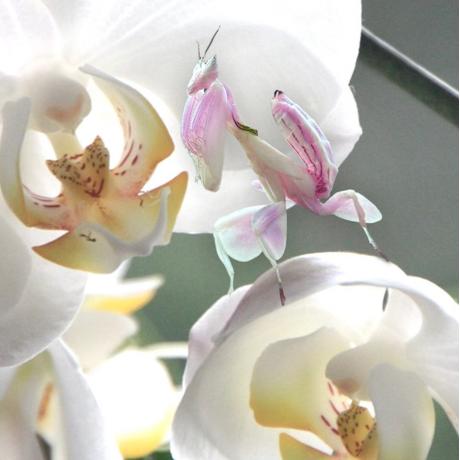

The Orchid Praying Mantis has to be one of the most beautiful Mantids within the hobby. It mimics an Orchid flower and will sit and wait for prey to visit for pollen.
Doesn't it's name give it away? With it's pointed eyes and petal like shapes on it's walking legs, resembling flowers is what it does best.
Colours vary during their life cycle. When newly hatched from the Ootheca (mantis egg), they are a strange bright red and black colour (a bit like Aliens). After the first shed, they tend to be a pinkish colour which lightens as they become mature. The adult females are mainly white with some brown markings and they have a green haze over the wings. The females measure roughly 60mm, where as the males are very small measuring only 30mm in size. This is half the size of a female!!! Males again are white with more brown markings but they do not have the green haze over the wings.
Indonesia, Malaysia and Sumatra rain forests. Hiding between large pink and white flowers, mainly Orchids, they lie in wait for insects. Needing a higher temperature and humididty level then most, the temperature should be 25 - 30C and humidity at 80 - 90%. To keep this right, which is very important, spray at least two times daily. Keep the cage/tank very ventilated to stop build up of water.
If you have the temperature and humidity levels, then get this breed. It's well worth all the extra hard work, keeping everything just right.
Feeding is a bit more trickier too. Unlike other Mantids, feeding them on mainly crickets and locusts etc., the Orchid needs more of it's natural foods. Some examples are: Flies, Moths, Butterflies, Bees and any other flower insects. In the summer this isn't a problem catching your own insects to feed them. In the winter, you will have to feed them wax worms (a grub from a moth), flies from fishing shops and the odd cricket.
We wouldn't recommend keeping these together after they have passed their 3rd shed! We kept quite a few together with ample food, only to find a large loss.